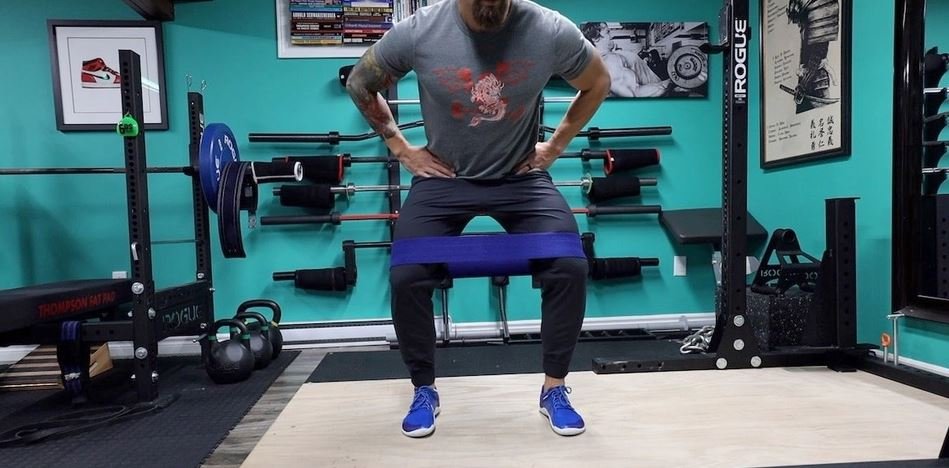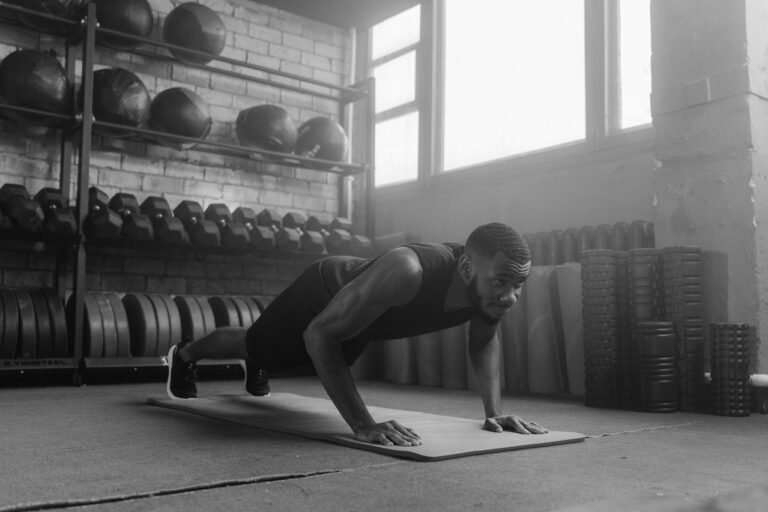Monster Walk Exercise: Ultimate Guide to Benefits, Techniques, and Injury Prevention
To commence, the monster walk exercise as intriguing as its name sounds, is a compelling exercise that targets the lower body, especially the glutes and hip abductors. Let’s dive right in and discover how to execute this dynamic movement flawlessly.
- Stand upright with feet hip-width apart. Equip yourself with a resistance band and place it either above your knees or around your ankles, depending on your fitness level and the band’s resistance.
- Engage your core and bend slightly at the knees, assuming a mini-squat position.
- Start walking sideways, leading with one foot and then following with the other, maintaining tension in the band. Usually, a set includes a specific number of steps in one direction, then back in the opposite direction.
Monster Walk Exercise: Unlocking the Secrets to Stronger Glutes
Now, you might wonder what makes the monster walk exercise so special? Primarily, it isolates and targets the gluteus medius, a commonly underworked muscle. Strengthening this muscle not only contributes to a toned appearance but also improves overall stability and reduces the risk of injuries.
Why the Monster Walk Exercise is a Game-Changer for Your Lower Body
Furthermore, while many exercises focus on the more prominent muscles like the quadriceps and hamstrings, the monster walk exercise fills a critical niche. It aids in enhancing hip mobility and stability, essential for athletes and non-athletes alike. A strong and mobile hip can be the difference between fluid motion and potential strain or injury.
Monster Walk Exercise: A Comprehensive Guide for Beginners
If you’re a newbie to this, worry not! Starting with the basics, first, choose a resistance band of moderate resistance. The goal is to feel tension but not be overwhelmed. As your strength and stamina build, you can then progress to stronger bands. Remember, it’s essential to maintain proper form, even if it means starting with a lighter resistance.
Benefits of the Monster Walk Exercise: More Than Just a Fun Name
In addition to muscle toning and injury prevention, the benefits of the monster walk exercise are vast. It improves posture, aids in better weight distribution during physical activities, and also serves as an excellent warm-up or cool-down routine.
10 Tips to Perfect Your Monster Walk Exercise Form
Lastly, as with any exercise, the form is paramount. Here are some pro tips to elevate your monster walk exercise:
- Keep your chest up and look straight ahead.
- Ensure consistent tension in the resistance band.
- Avoid leaning too far forward or backward.
- Engage your core throughout the exercise.
- Maintain a slight bend in the knees.
- Focus on smooth, controlled movements rather than speed.
- Ensure your feet remain parallel to each other.
- Avoid letting your knees cave in.
- Breathe evenly and don’t hold your breath.
- Consistency is key; practice makes perfect.

From Novice to Pro: Enhancing Your Monster Walk Exercise Technique
Embarking on a fitness journey often begins with foundational exercises. Among these is the monster walk exercise, a low-impact yet highly effective movement targeting the glutes, hips, and thighs. Like any exercise, starting with the basics and progressively refining your technique is crucial. Here’s a step-by-step progression:
- Posture and Stance: Begin by standing with feet hip-width apart. Engage your core and maintain a slight bend in your knees. This neutral stance is your starting point.
- Sideways Movement: Initiate the monster walk by stepping out to the side with one foot, followed by the other. The key is to maintain tension in the muscles throughout the movement.
- Controlled Steps: Instead of rushing through the steps, move with intention. Slow and controlled steps ensure optimal muscle engagement.
Monster Walk Exercise: The Ultimate Move for Hip and Thigh Strength
In the realm of lower body exercises, the monster walk exercise stands out for its emphasis on hip and thigh strength. The sideways movement uniquely activates the gluteus medius – a muscle often neglected in standard front-to-back exercises. Consequently, this makes the monster walk an indispensable tool for athletes, fitness enthusiasts, and even individuals in rehab.
Common Mistakes to Avoid in the Monster Walk Exercise
However, as with all exercises, there are pitfalls to watch out for:
- Losing Posture: It’s easy to hunch forward or let the upper body sway. Consistently check your posture to remain upright.
- Overextending the Step: Taking steps that are too wide can strain the hip flexors. Keep steps moderate and controlled.
- Not Engaging the Core: A disengaged core can lead to a misaligned spine. Ensure the core is active throughout.
Resistance Bands and Monster Walk Exercise: A Match Made in Fitness Heaven
Introducing resistance bands to your monster walk exercise can elevate its impact. The added resistance challenges the glutes and thighs even more, fostering muscle growth and improved strength. Moreover, resistance bands are versatile and come in varying tension levels, catering to both novices and pros.
Monster Walk Exercise Variations: Boosting Intensity and Effectiveness
Finally, once you’ve mastered the basic technique, it’s time to explore variations:
- Forward Monster Walks: Instead of moving sideways, take steps forward while maintaining the lateral tension.
- Reverse Monster Walks: As the name suggests, this involves stepping backward, activating different muscle fibers.
- Incorporate Squats: After every few steps, drop into a squat. This adds a compound element to the routine, increasing its intensity.
Rehab and Recovery: How the Monster Walk Exercise Supports Injury Prevention
The world of fitness is replete with exercises designed to tone, strengthen, and challenge our bodies. Yet, few exercises offer both rehabilitative benefits and functional strength like the monster walk exercise. For athletes and fitness enthusiasts alike, injury prevention is paramount. Engaging in exercises that not only fortify our muscles but also safeguard them against potential injuries is a smart strategy.
A significant aspect of rehab and recovery post-injury is to rebuild strength without straining the affected area. Here’s where the monster walk exercise shines. By targeting the gluteus medius, a muscle often overlooked in conventional workouts, it plays a pivotal role in stabilizing the hips and protecting the knees. Weakness or imbalances in this muscle can lead to knee injuries, making the monster walk an excellent exercise for those in the recovery phase.

Monster Walk Exercise: Incorporating It Into Your Daily Workout Routine
Incorporating the monster walk exercise into your daily routine doesn’t require an overhaul of your existing regimen. It’s the kind of exercise that seamlessly fits, serving as a warm-up or even a cooldown. For those focused on lower body workouts, it’s an invaluable addition.
Start by including it as a pre-workout warm-up. This primes the hips and knees for the exercises to follow, ensuring they are engaged and activated. Alternatively, slotting it into your cooldown can help in reducing post-workout muscle soreness, thanks to its low-impact nature.
The Science Behind Monster Walk Exercise: What Muscles Are You Really Working?
At first glance, the monster walk exercise might seem simple, almost deceptive in its ease. Yet, delve a bit deeper, and the science unfolds its magic. The primary muscle targeted is the gluteus medius. This muscle, located on the outer side of the hip, is crucial for pelvic stabilization and leg abduction.
But it doesn’t stop there. The monster walk also engages the core, providing a steady workout for the abdominal muscles. Additionally, the quadriceps, hamstrings, and calves get their fair share of action, making it a comprehensive lower body exercise.
Dive into the Monster Walk Exercise: Tips, Tricks, and Training Plans
Diving headfirst into any exercise without proper knowledge can be counterproductive. So, here are a few tips and tricks to make the most of the monster walk exercise:
- Form is King: Ensure your posture is correct. Keep the back straight and avoid leaning forward or sideways.
- Mind the Resistance: Using a resistance band? Choose the right level. Starting with lighter resistance and progressing as your strength improves is the way to go.
- Consistency is Key: Like all exercises, the monster walk offers maximum benefits when done consistently. Aim for 2-3 times a week to start.
- Training Plans: Consider pairing the monster walk with exercises like squats, lunges, and leg presses for a comprehensive lower body workout.







